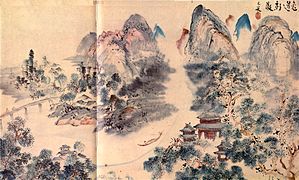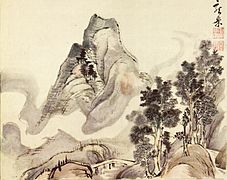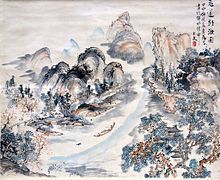Aoki Mokubei
Aoki Mokubei ( Japanese 青木 木 米 ; * 1767 in Kyoto ; † July 2, 1833 ; real name Gensa ( 玄 佐 )) was a Japanese potter and painter of the Nanga style.
Life
Aoki, the son of a tea house owner on the Kamo River in Kyoto , showed an extraordinary interest in antiques early on. He studied painting under Kō Fuyō ( 高 芙蓉 ; 1722–1784), who introduced him to the basics of Nanga painting. Then he visited in 1798 Kimura Kenkadō , who made him familiar with calligraphy and also with old ceramics. At this time he began himself under Okuda iron (1753-1811) with pottery, where he signed his objects with Tōkō Mokubei . His experience with decorating ceramics formed the basis for his further development as a painter. From 1801 he worked as a potter among the Kii-Tokugawa , from 1807 for the Maeda in Kanazawa .
As a painter, Aoki was most active in the later half of the Bunsei era (1818–1829), varying his style. His sense of color, especially his use of transparent indigo and red, suggests his ceramic experience. One of his best-known works is the picture “Sunny Morning on the Uji River ”.
Aoki was friends with Tanomura Chikuden , who rated him as one of the best nanga painters alongside Ike no Taiga .
gallery
Remarks
- ↑ Other Go (stage names) were Hyakuroku Sanjin ( 百 六 散 人 ), Kokikan ( 古 器 観 ), Kukurin ( 九 々 麟 ), Rōbei ( 聾 米 ) and Teiunrō ( 停 雲楼 ).
- ↑ Tōkō ( 陶工 ) means potter.
- ^ Ohara Art Museum .
- ↑ Toyama Art Museum, Saitama Prefecture .
- ↑ Tokyo National Museum .
literature
- Tazawa Yutaka: Biographical Dictionary of Japanese Art . Kodansha International, 1981. ISBN 0-87011-488-3 .
- Laurance P. Roberts: A Dictionary of Japanese Artists. Weatherhill, 1976. ISBN 0-8348-0113-2 .
- Yonezawa and Yoshizawa: Japanese Painting in the Literati Style , Weatherhill / Heibonsha, 1974. ISBN 0-8348-1019-0 .
Web links
| personal data | |
|---|---|
| SURNAME | Aoki, Mokubei |
| ALTERNATIVE NAMES | 青 木木 米 (Japanese, stage name); 青木 玄 佐 (real name, Japanese); Aoki Gensa (real name) |
| BRIEF DESCRIPTION | Japanese potter and painter |
| DATE OF BIRTH | 1767 |
| PLACE OF BIRTH | Kyoto |
| DATE OF DEATH | July 2, 1833 |
| Place of death | Kyoto |






